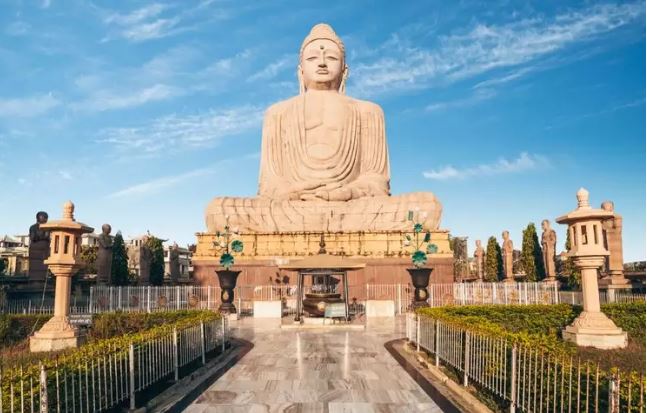Table of Contents
ToggleTop 10 Facts About Bihar: Unveiling the Rich Heritage and Legacy
The eastern Indian state of Bihar is renowned for its rich cultural legacy and extensive historical significance. India’s history has been shaped by the ancient civilizations, empires, and spiritual movements that originated there.
Bihar is one of the most venerated locations for Buddhists worldwide since it is known as the spot where Lord Buddha received enlightenment in Bodh Gaya. The state is also the location of the historic Nalanda University, which was a globally renowned hub of learning in ancient India.

Several empires have come and gone from Bihar throughout history, notably the Mauryan and Gupta dynasties. Its capital, Patna, was formerly the prosperous city of Pataliputra, an important political and power hub in ancient India. The state was home to leaders of the Indian independence movement such as Jayaprakash Narayan and Dr. Rajendra Prasad, and they made substantial contributions to the cause.
Bihar has a vibrant culture, and holidays like Chhath Puja are very important. The state’s simplicity and depth of flavor are reflected in the native cuisine, which includes items like litti chokha and sattu paratha.
Notwithstanding its historical and cultural importance, Bihar has experienced difficulties with infrastructure, education, and growth. Nonetheless, the state keeps developing, and its citizens are renowned for their tenacity and diligence.
Bihar strives for a better future while serving as a reminder of India’s magnificent heritage.
In this blog, we will explore ten fascinating facts about Bihar that highlight its enduring legacy and contribution to India’s cultural, political, and spiritual heritage.
1. The Origins of Jainism and Buddhism
Bihar is widely acknowledged for being the cradle of two of the major world faiths, Buddhism and Jainism. Around the sixth century BCE, Siddhartha Gautama, the future Buddha, acquired enlightenment under the Bodhi Tree in the village of Bodh Gaya. Bodh Gaya continues to be a popular destination for millions of Buddhists worldwide on pilgrimages. A UNESCO World Heritage Site, the Mahabodhi Temple is a representation of spirituality and harmony.
In Jainism, too, Bihar has a particular place. Around 599 BCE, Lord Mahavira, the 24th Tirthankara, was born in Vaishali, another ancient Bihari city. With its wealth of spiritual importance and historical artifacts, Vaishali is still a significant location for Jains.
Cultural Significance
The spiritual fabric of the world, including India, has been profoundly impacted by both religions. These religions are the source of the ethical precepts of non-violence, compassion, and asceticism, which have shaped the global conversation on morality and peace.
2. The Ancient Nalanda University
One of the first residential universities in history, Nalanda University was founded in Bihar in the fifth century CE. This educational hub drew intellectuals from all over the world, including China, Tibet, Korea, Japan, and Southeast Asia. It was situated in the modern-day Nalanda area. Nalanda was a center of scholarship, with specializations in philosophy, logic, medicine, mathematics, and Buddhist studies.
Even though it was eventually destroyed by invaders in the twelfth century, the ruins of Nalanda showcase the magnificence of the historic educational system. Reviving Nalanda University, which represents a link between the goals of education in the past and the present, has been an ongoing endeavor in recent years.
Intellectual Legacy
The legacy of Nalanda bears witness to India’s longstanding academic and philosophical traditions. The remnants serve as a reminder of Bihar’s role in the advancement of knowledge and academic distinction.
The New Nalanda University Campus
New Nalanda University, established in 2010, is a modern reincarnation of the ancient Nalanda University.
The president of India serves as the institution’s visitor. The university was founded in 2010 by an Act of the Indian Parliament.
On June 19, 2024, Indian Prime Minister Narendra Modi officially opened the new campus in front of dignitaries, diplomats, and representatives from all 18 ASEAN members.
3. The Mauryan Dynasty and Magadha: The Power of Empires
The establishment of strong empires is also connected to the historical significance of Bihar. Known for its capital city of Pataliputra (present-day Patna), the ancient Magadha area was home to two of the most powerful empires in history: the Maurya Dynasty and the Gupta Empire.
One of the biggest empires in Indian history was established by Chandragupta Maurya, the founder of the Maurya Dynasty, who brought most of the Indian subcontinent under his control in the fourth century BCE. Following the Kalinga War, his grandson Emperor Ashoka converted to Buddhism and is credited with introducing the religion throughout Asia.
Often referred to as India’s Golden Age, the Gupta Empire succeeded the Mauryas and is remembered for its advancements in astronomy, mathematics, science, and literature. The Guptas made significant contributions to ancient Indian culture, and their inventions are still influencing contemporary Indian society.
Cultural and Political Achievements
The ancient empires of Bihar established the groundwork for India’s political unification and cultural advancement. The administrative, social, and artistic frameworks of India were shaped in large part by these empires.

4. Vaishali: The First Democratic Republic in the World
Bihar is also the home of Vaishali, which is thought to have been the earliest democratic republic in history, dating back to the sixth century BCE. Voting was used to elect officials in the Vajji Confederation, which dominated the area. This system was an early form of democracy.
Since monarchy was the norm for kings and rulers in other regions of the world, Vaishali’s unique political structure was avant-garde. Since then, Vaishali’s concept of group leadership and governance has developed and impacted other democratic systems around the world.
Governance and Diplomacy
Bihar has made a significant contribution to political philosophy; Vaishali’s government model is an example of early democratic experimentation. This antiquated type of democracy serves as a reminder of Bihar’s creative and innovative approach to governance.
5. Rich Folk Culture and Festivals
Generation after generation has left behind a rich and varied folk culture in Bihar. The three main languages spoken in the state are Bhojpuri, Maithili, and Magahi, each of which has a rich literary history of its own. Bihar’s folk music, dances, and festivals are essential components of its culture.
Chhath Puja, a highly revered festival honoring the Sun God, is one of Bihar’s most well-known celebrations. On the banks of rivers and ponds, people offer prayers to the setting and rising sun during this event, which is notable for its simplicity.
In addition, Bihar celebrates Durga Puja, Holi, Diwali, and Makar Sankranti. The zeal with which these festivals are observed demonstrates the state’s devotion to spirituality and tradition.
Cultural Diversity
The profound spiritual and natural ties of the people of Bihar are reflected in their folk customs. Its cultural celebrations bring people together across class and religious divides.
6. Historical Contribution to Indian Independence
Bihar was essential to India’s fight for freedom. In 1917, the Champaran Satyagraha, spearheaded by Mahatma Gandhi, originated in this state. Gandhi’s first major campaign in India addressed the mistreatment of Indian producers at the hands of British planters.
Strong support for the Quit India Movement and other nationalist initiatives was also seen in Bihar, where notable figures in the freedom struggle included Rajendra Prasad, Jayaprakash Narayan, and Anugrah Narayan Sinha.
Legacy of Freedom Fighters
Bihar holds a significant position in the history of India due to its affiliation with the freedom cause. Future generations will continue to be inspired by the state’s memory-resonant involvement in India’s freedom movement.
7. Patna Sahib: A Significant Sikh Site of Pilgrimage
One of the five Takhts (holy seats of power) of Sikhism is Takht Sri Patna Sahib, located in Patna, the capital of Bihar. In 1666, Guru Gobind Singh, the tenth and final Sikh Guru, was born in this location. Every year, hundreds of pilgrims visit the Patna Sahib Gurdwara, particularly on the occasion of Guru Gobind Singh Jayanti.
In Sikhism, the Gurdwara is seen as a sign of faith and devotion and houses historical treasures. As the Sikh community’s spiritual center, Bihar has made a significant historical contribution.
Religious Significance
Patna Sahib is a symbol of Bihar’s tolerance for all faiths and its commitment to fostering spiritual harmony. The Gurdwara provides evidence of the variety of religions practiced in the state.

8. The Emergence of Modern Education and Technology
Bihar is advancing in both technology and education in the present era. The Indian Institute of Technology (IIT), Patna, and Nalanda University are a few examples of the state’s prestigious educational institutions. Notable academics, legislators, and government employees from Bihar have significantly aided India’s progress.
Technological Advancement
The growth of scientific, engineering, and social science institutions indicates that Bihar is committed to moving forward and adjusting to the demands of contemporary education, even though the state may yet confront difficulties.
9. The Well-Known Bihari and Litti Chokha Cuisine
Bihar’s customs and rural origins are closely linked to its gastronomic legacy. Litti Chokha, a delicacy prepared from wheat flour balls filled with roasted gram flour and served with mashed potatoes, brinjal, or tomatoes, is one of the state’s most well-known delicacies. In addition to being a hit in Bihar, Litti Chokha is becoming more and more well-liked all over India.
Thekua, Khaja, Dal Pitha, and Sattu Paratha are some other noteworthy foods. The usage of locally sourced ingredients and the agrarian lifestyle of Bihar are reflected in these meals.
Culinary Heritage
Bihar’s cuisine offers a sense of rural India and is a representation of its rich agricultural traditions and simplicity. Bihari cuisine’s flavors are becoming well-known both domestically and abroad, and they are still expanding well beyond its boundaries.
10. The Ancient River Civilization: Ganga and Sone
Several of India’s principal rivers, including the Ganga, Sone, Gandak, and Kosi, are found in Bihar. The Ganges River holds great spiritual significance for the Bihari people in addition to being a vital source of water for agriculture. In Hindu tradition, the river is considered sacred, and people perform rituals and make prayers along it.
The well-known aartis of Varanasi and Haridwar are comparable to the Ganga Aarti done in Patna. Bihar’s profound spirituality and closeness to the natural world are reflected in this daily ritual performed by the riverside.
Environmental Importance
The people of Bihar rely on the rivers to sustain them and maintain the ecological balance of the area. For the sake of the state’s future prosperity, these rivers must be preserved.

